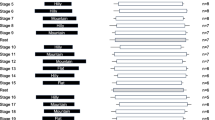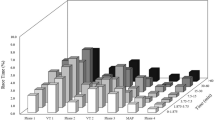Abstract
This study examined the relationship between mood and rating of perceived exertion (RPE) during a simulated multiple-lap time trial (MLTT). Nineteen male cyclists performed a MLTT consisting of four 9.9 km laps, each lap with a gradient ranging from 0 to 10 %. Mood as measured by the Profile of Mood States Questionnaire (POMS) and perceived exertion as measured by the Borg CR100 scale (RPE) were obtained at the end of each lap. A categorical multiple regressive model, having median of POMS subscales as independent variables, was obtained to explain the variance in median RPE responses. Increases in POMS fatigue scores and decreases in POMS vigour scores were observed throughout the MLTT (P < 0.001). A linear increase in RPE during the MLTT was also observed (P < 0.001). POMS fatigue subscale scores accounted for 88 % of the variance in RPE during the MLTT (R2 = 0.88, P = 0.002), and no other POMS subscale improved the final predictive model. With the exception of fatigue these results suggest that most aspects of mood do not have a discernable effect on RPE during a MLTT. The rate of increase in RPE can predict the MLTT endpoint.




Similar content being viewed by others
References
Abbiss, C. R., & Laursen, P. B. (2008). Describing and understanding pacing strategies during athletic competition. Sports Medicine, 38(3), 239–252.
Baden, D. A., Warwick-Evans, L., & Lakomy, J. (2004). Am I nearly there? The effect of anticipated running distance on perceived exertion and attentional focus. Journal of Sport and Exercise Psychology, 26(2), 17.
Baron, B., Moullan, F., Deruelle, F., & Noakes, T. D. (2011). The role of emotions on pacing strategies and performance in middle and long duration sport events. British Journal of Sports Medicine, 45(6), 511–517. doi:10.1136/bjsm.2009.059964.
Borg, E., & Borg, G. (2002). A comparison of AME and CR100 for scaling perceived exertion. Acta Psychologica (Amst), 109(2), 157–175.
Borg, E., & Kaijser, L. (2006). A comparison between three rating scales for perceived exertion and two different work tests. Scandinavian Journal of Medicine and Science in Sports, 16(1), 57–69. doi:10.1111/j.1600-0838.2005.00448.x.
Corbett, J., Barwood, M. J., Ouzounoglou, A., Thelwell, R., & Dicks, M. (2012). Influence of competition on performance and pacing during cycling exercise. Medicine and Science in Sports and Exercise, 44(3), 509–515. doi:10.1249/MSS.0b013e31823378b1.
Ekkekakis, P., Parfitt, G., & Petruzzello, S. J. (2011). The pleasure and displeasure people feel when they exercise at different intensities: Decennial update and progress towards a tripartite rationale for exercise intensity prescription. Sports Medicine, 41(8), 641–671. doi:10.2165/11590680-000000000-00000.
Eston, R., Faulkner, J., Gibson, A. S. C., Noakes, T., & Parfitt, G. (2007). The effect of antecedent fatiguing activity on the relationship between perceived exertion and physiological activity during a constant load exercise task. Psychophysiology, 44(5), 779–786. doi:10.1111/j.1469-8986.2007.00558.x.
Foster, C., Hendrickson, K. J., Peyer, K., Reiner, B., deKoning, J. J., Lucia, A., & Wright, G. (2009). Pattern of developing the performance template. British Journal of Sports Medicine, 43(10), 765–769. doi:10.1136/bjsm.2008.054841.
Gibson, A. S. C., Baden, D. A., Lambert, M. I., Lambert, E. V., Harley, Y. X., Hampson, D., & Noakes, T. D. (2003). The conscious perception of the sensation of fatigue. Sports Medicine, 33(3), 167–176.
Gibson, A. S. C., Lambert, E. V., Rauch, L. H., Tucker, R., Baden, D. A., Foster, C., & Noakes, T. D. (2006). The role of information processing between the brain and peripheral physiological systems in pacing and perception of effort. Sports Medicine, 36(8), 705–722. doi:10.2165/00007256-200636080-00006.
Gibson, A. S. C., & Noakes, T. D. (2004). Evidence for complex system integration and dynamic neural regulation of skeletal muscle recruitment during exercise in humans. British Journal of Sports Medicine, 38(6), 797–806. doi:10.1136/bjsm.2003.009852.
Hair, J. F. (1998). Multivariate data analysis. Upper Saddle River, NJ: Prentice Hall.
Jackson, A. S., & Pollock, M. L. (1978). Generalized equations for predicting body density of men. British Journal of Nutrition, 40(3), 497–504.
Kilpatrick, M., Kraemer, R., Bartholomew, J., Acevedo, E., & Jarreau, D. (2007). Affective responses to exercise are dependent on intensity rather than total work. Medicine and Science in Sports and Exercise, 39(8), 1417–1422. doi:10.1249/mss.0b013e31806ad73c.
Kuipers, H., Verstappen, F. T., Keizer, H. A., Geurten, P., & van Kranenburg, G. (1985). Variability of aerobic performance in the laboratory and its physiologic correlates. International Journal of Sports Medicine, 6(4), 197–201. doi:10.1055/s-2008-1025839.
Mauger, A. R., Jones, A. M., & Williams, C. A. (2009). Influence of feedback and prior experience on pacing during a 4-km cycle time trial. Medicine and Science in Sports and Exercise, 41(2), 451–458. doi:10.1249/MSS.0b013e3181854957.
Micklewright, D., Papadopoulou, E., Parry, D., Hew-Butler, T., Tam, N., & Noakes, T. (2009). Perceived exertion influences pacing among ultramara-thon runners but post-race mood change is associated with performance expectancy. South African Journal of Sports Medicine, 21(4), 167–172.
Noakes, T. D. (2004). Linear relationship between the perception of effort and the duration of constant load exercise that remains. Journal Applied Physiology (1985), 96(4), 1571–1572. doi:10.1152/japplphysiol.01124.2003. (author reply 1572–1573).
Norton, K., & Olds, T. (1996). Anthropometrica. Sidney: The International Society for the Advancement of Kinathropometry.
Nyenhuis, D. L., Yamamoto, C., Luchetta, T., Terrien, A., & Parmentier, A. (1999). Adult and geriatric normative data and validation of the profile of mood states. Journal of Clinical Psychology, 55(1), 79–86. doi:10.1002/(SICI)1097-4679(199901)55:1<79:AID-JCLP8>3.0.CO;2-7.
Parry, D., Chinnasamy, C., Papadopoulou, E., Noakes, T., & Micklewright, D. (2011). Cognition and performance: Anxiety, mood and perceived exertion among Ironman triathletes. British Journal of Sports Medicine, 45(14), 1088–1094. doi:10.1136/bjsm.2010.072637.
Pires, F. O., Lima-Silva, A. E., Bertuzzi, R., Casarini, D. H., Kiss, M. A., Lambert, M. I., & Noakes, T. D. (2011). The influence of peripheral afferent signals on the rating of perceived exertion and time to exhaustion during exercise at different intensities. Psychophysiology, 48(9), 1284–1290. doi:10.1111/j.1469-8986.2011.01187.x.
Roelands, B., de Koning, J., Foster, C., Hettinga, F., & Meeusen, R. (2013). Neurophysiological determinants of theoretical concepts and mechanisms involved in pacing. Sports Medicine, 43(5), 301–311. doi:10.1007/s40279-013-0030-4.
Rose, S., & Peters-Futre, E. M. (2010). Ad libitum adjustments to fluid intake during cool environmental conditions maintain hydration status during a 3-day mountain bike race. British Journal of Sports Medicine, 44(6), 430–436. doi:10.1136/bjsm.2008.049551.
Tucker, R. (2009). The anticipatory regulation of performance: The physiological basis for pacing strategies and the development of a perception-based model for exercise performance. British Journal of Sports Medicine, 43(6), 392–400. doi:10.1136/bjsm.2008.050799.
Tucker, R., Marle, T., Lambert, E. V., & Noakes, T. D. (2006). The rate of heat storage mediates an anticipatory reduction in exercise intensity during cycling at a fixed rating of perceived exertion. Journal of Physiology, 574(Pt 3), 905–915. doi:10.1113/jphysiol.2005.101733.
Viana, M. F., Almeida, P. L. D., & Santos, R. C. (2001). Adaptação portuguesa da versão reduzida do perfil de estados de humor - POMS. Análise Psicológica, 1, 77–92.
We, S. (1961). Body composition from fluid spaces and density. Washington, DC: National Academy of Science.
Weston, S. B., Gray, A. B., Schneider, D. A., & Gass, G. C. (2002). Effect of ramp slope on ventilation thresholds and VO2peak in male cyclists. Interntional Journal of Sports Medicine, 23(1), 22–27. doi:10.1055/s-2002-19267.
Author information
Authors and Affiliations
Corresponding author
Ethics declarations
Conflict of interests
The authors declare has no conflicting interests.
Funding
No funding was required for this study.
Additional information
Bruno Ferreira Viana and Flávio Oliveira Pires have contributed equally to this study.
Rights and permissions
About this article
Cite this article
Viana, B.F., Pires, F.O., Inoue, A. et al. Correlates of Mood and RPE During Multi-Lap Off-Road Cycling. Appl Psychophysiol Biofeedback 41, 1–7 (2016). https://doi.org/10.1007/s10484-015-9305-x
Published:
Issue Date:
DOI: https://doi.org/10.1007/s10484-015-9305-x




